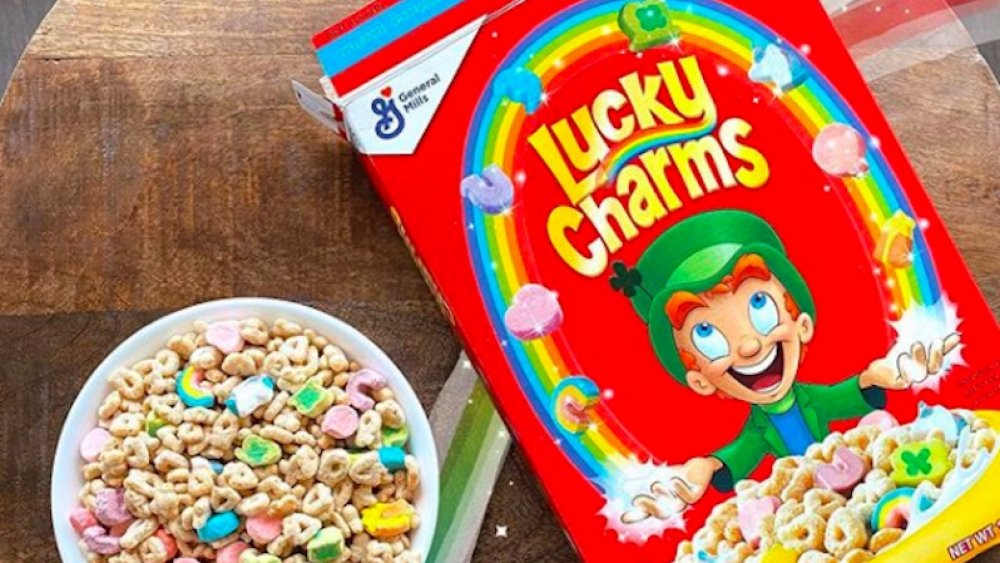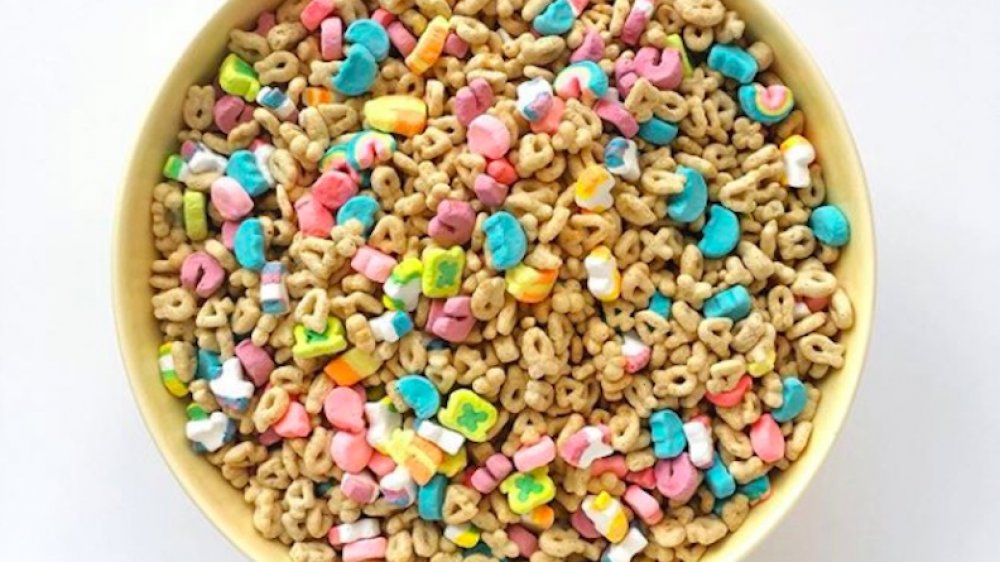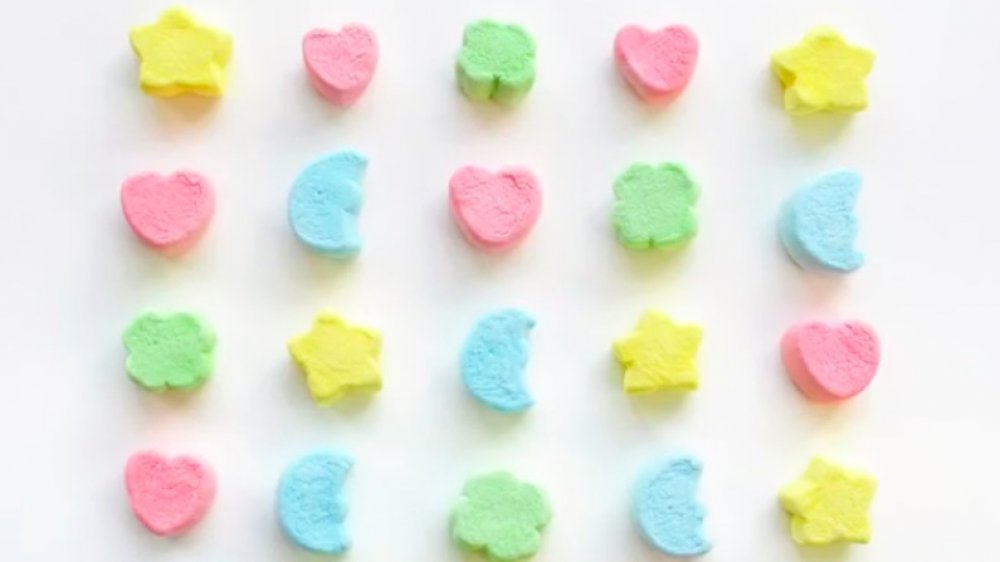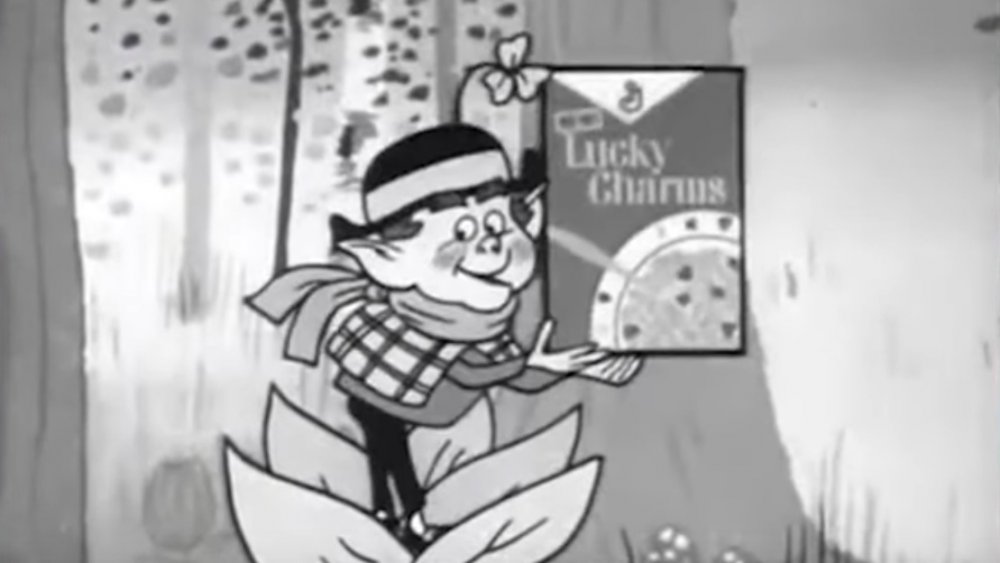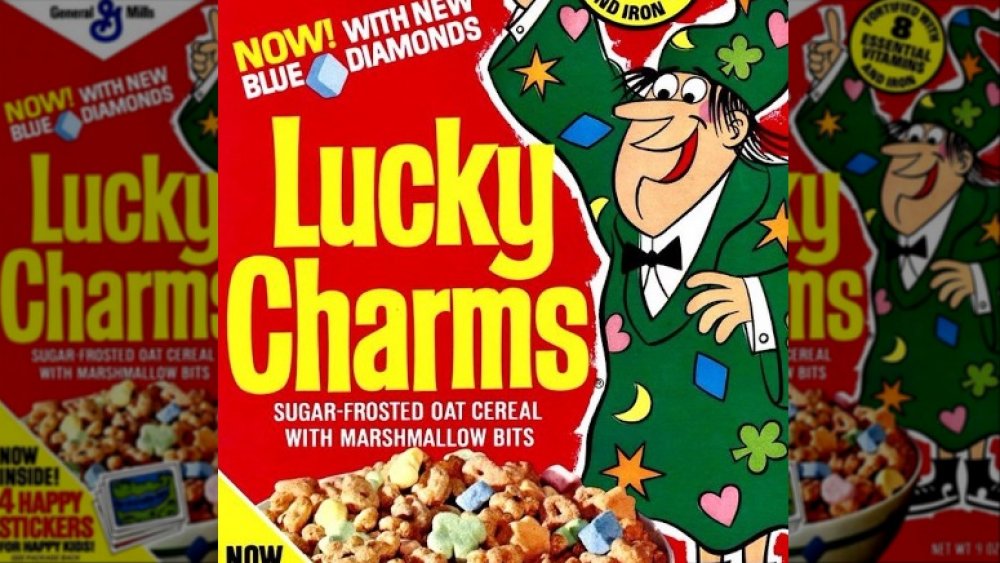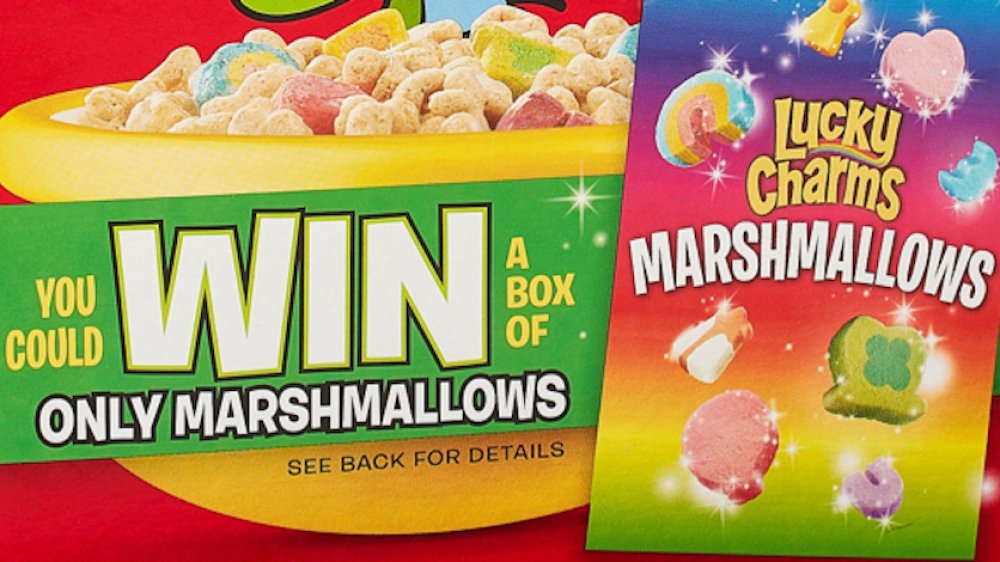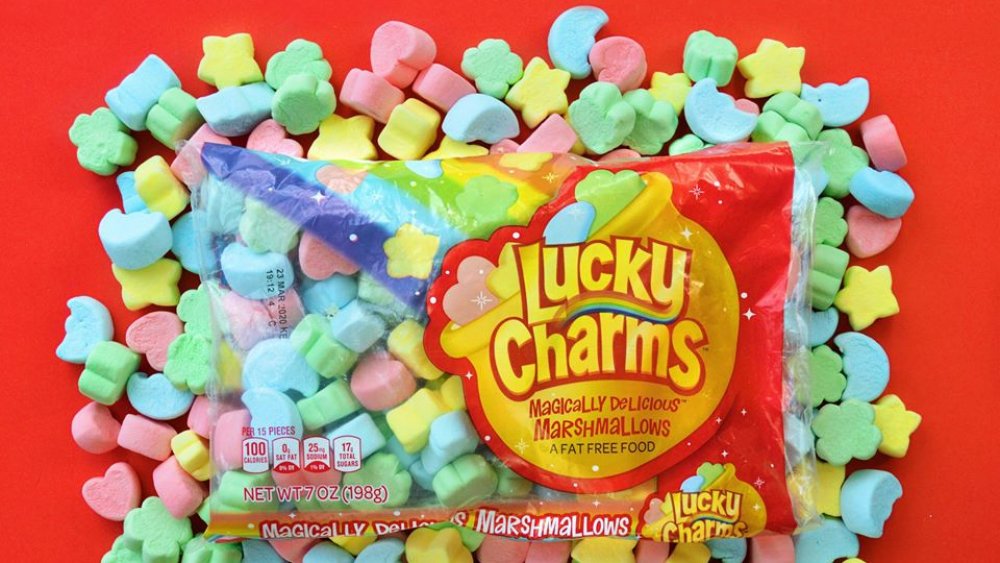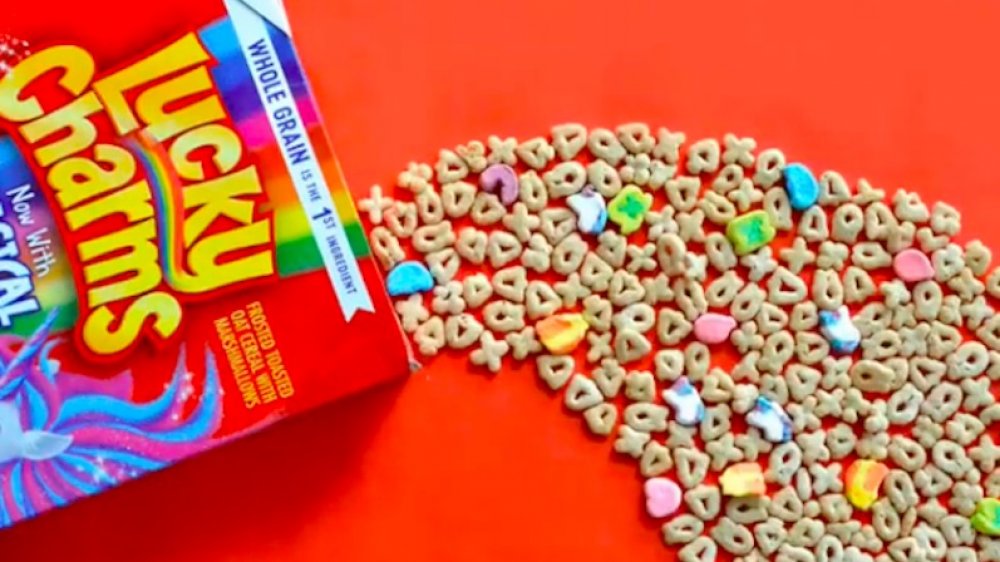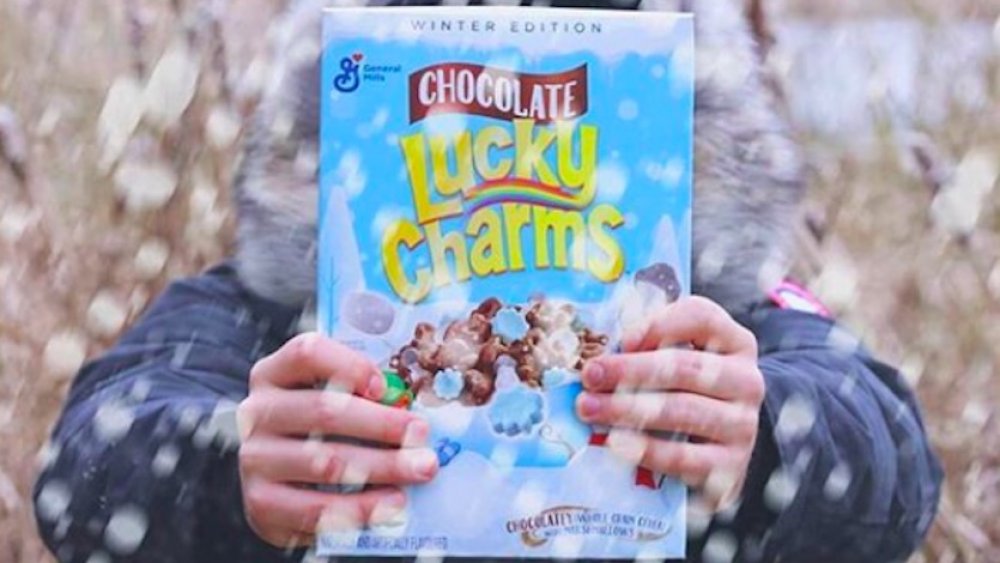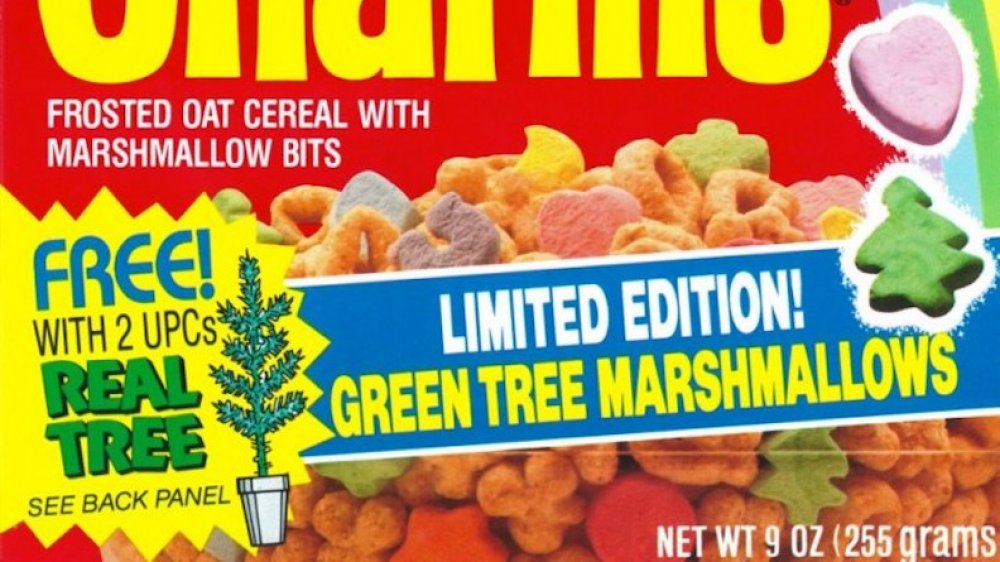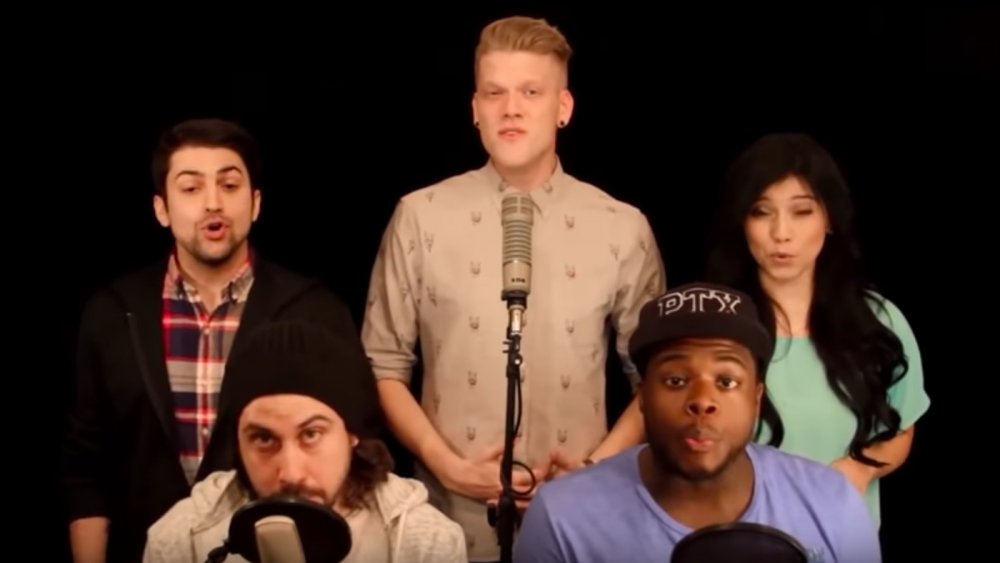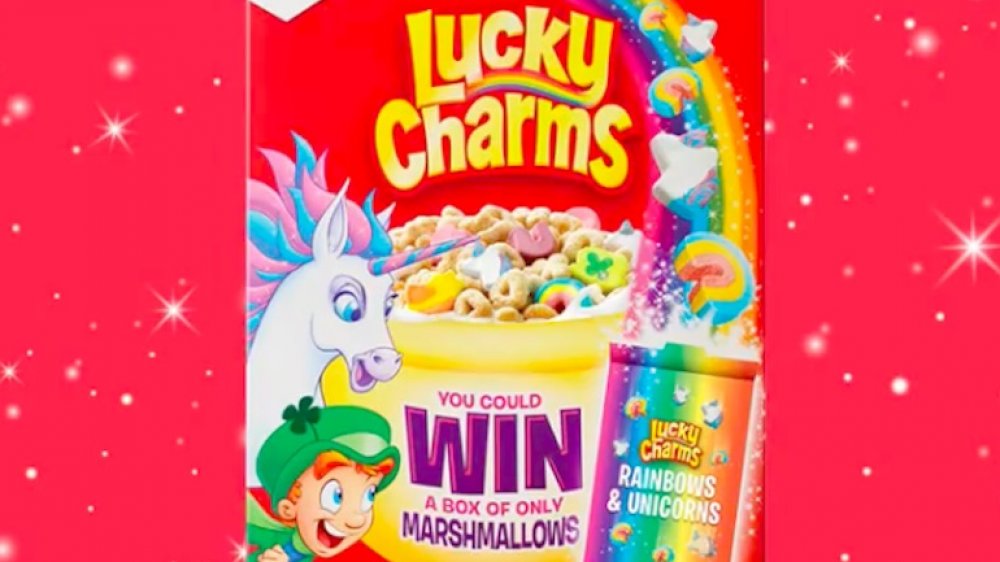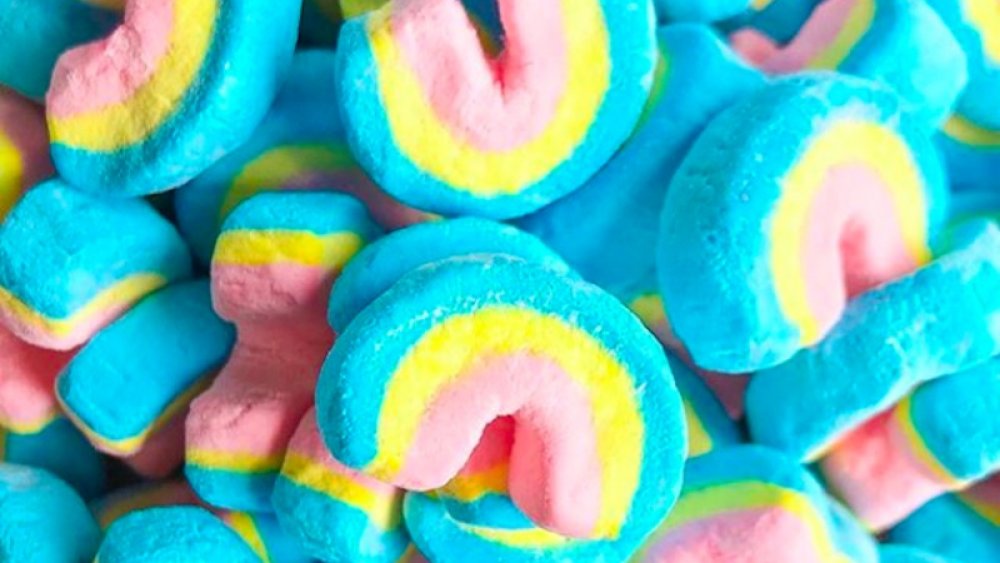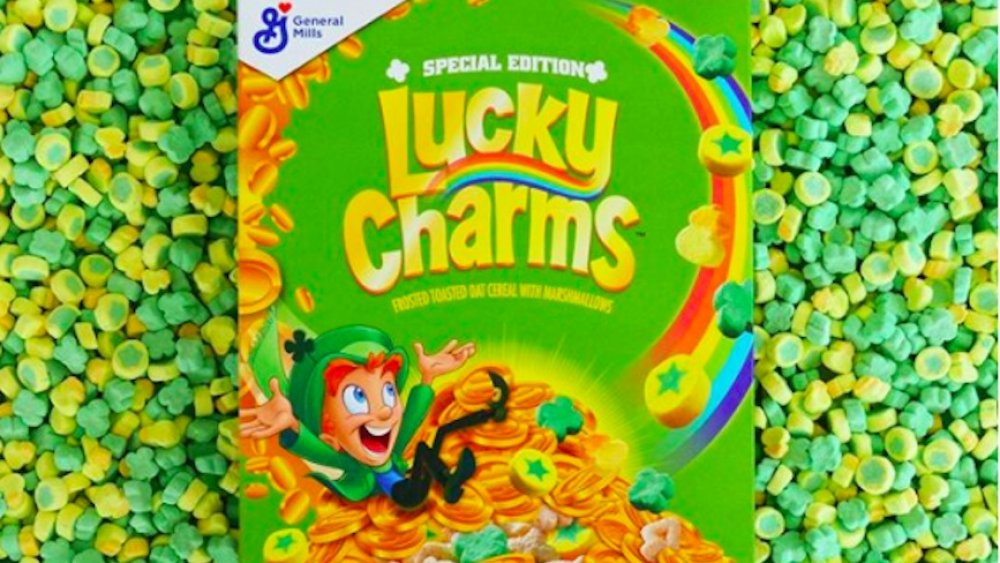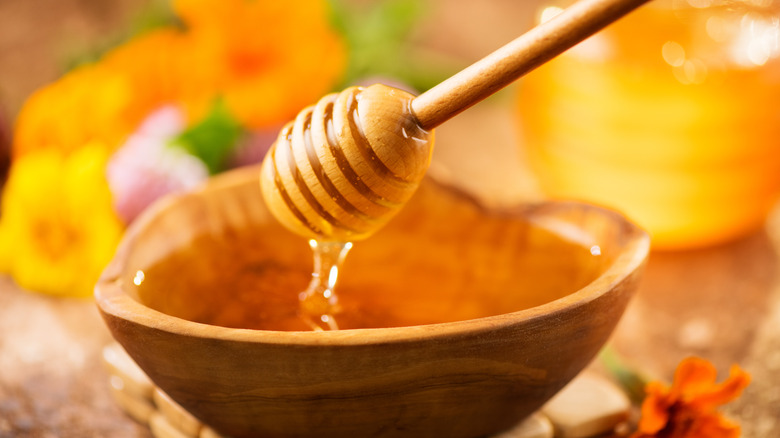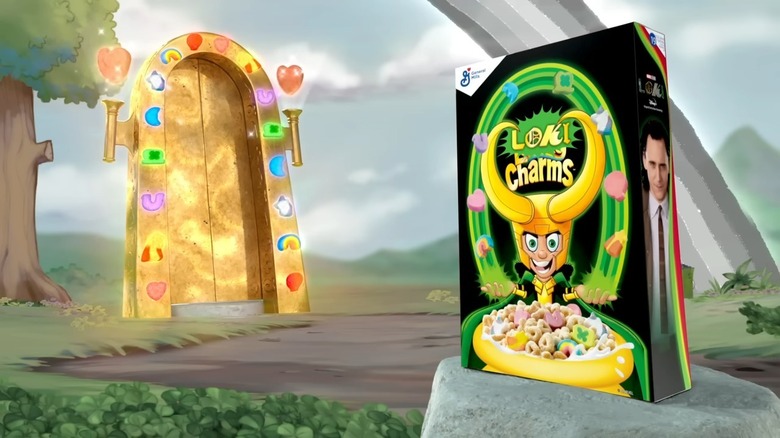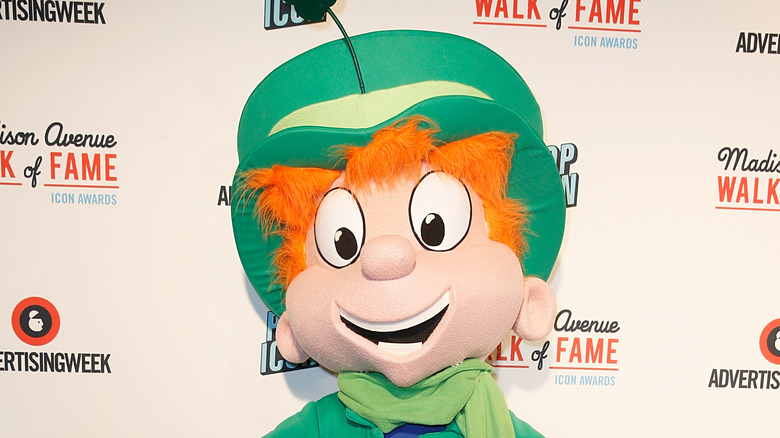What Only Superfans Know About Lucky Charms
First introduced to supermarket shelves in the mid-1960s, Lucky Charms have been a part of the breakfast cereal pantheon ever since. Kids eventually took to the "magically delicious" sugar-packed cereal, which could boast something that no other cereal at the time could offer: tiny marshmallow bits shaped like moons, hearts, stars and four-leafed clovers.
Of course, no breakfast cereal aimed at enticing children during the 1960s would be considered complete without a lovable cartoon mascot, and Lucky Charms had that covered thanks to the introduction of Lucky the leprechaun. The leprechaun has appeared in numerous TV commercials over the decades, involved in an ongoing storyline that has remained more or less unchanged since the beginning. In each commercial, the leprechaun uses all the magic powers at his disposal to evade hungry children who are always "after me Lucky Charms."
Lucky Charms has remained popular with consumers for more than half a century, but fans of the iconic breakfast cereal may be surprised by how much they don't know about this inventive combination of food-science experimentation and advertising mastery. Read on to discover the untold truth of Lucky Charms.
Lucky Charms has a strange link to Circus Peanuts
Oddly enough, the history of Lucky Charms is inexorably linked with that of the Circus Peanut, that most derided of candies. According to the Capital Times, legend has it that Lucky Charms came to be thanks to General Mills executive John Holahan, who was working on developing a new cereal that children would want so much they would beg their parents to buy it. One day, he had a crazy-yet-brilliant idea: Holahan chopped up some Circus Peanuts and sprinkled the marshmallow bits into a bowl of Cheerios. He loved what he tasted, immediately realizing that if he enjoyed the combination of crunchy cereal and soft marshmallows, so would consumers. "I knew we had a winner," he said of his idea.
Once the cereal was developed, noted a General Mills product timeline, Lucky Charms made its first appearance on supermarket shelves back in 1964. And while the cereal's formulation has been constantly reinvented over the years, General Mills representative Jim Geoffrion pointed to three key factors that explain why Lucky Charms continues to be an enduring favorite. "It's the marshmallows, it's the marshmallows, it's the marshmallows," he told BNet Business Network.
The Lucky Charms marshmallows have a weird name
Once the product was placed in development, the key element was perfecting the tiny marshmallow bits that would be mixed with the toasted oat cereal. The minuscule marshmallow pieces, BNet Business Network reported, initially came in just four distinct types: pink hearts, orange stars, yellow moons, and green clovers.
The unique formulation of Lucky Charms' marshmallows, noted Smithsonian Magazine, was initially created by a team of General Mills food scientists led by Philip Zietlow, and behind many of those delicious little marshmallow shapes lies a patent. These marshmallow bits came to be called marbits, a moniker that has stuck and continues to be used all these years later.
Lucky Charms remained unchanged for a full decade, with the cereal's marbit "gang of four" intact until 1975. It was then, reported HuffPost, that a blue diamond was added to the mix. According to a General Mills spokesperson, the addition of the blue diamond caused sales to spike by 30 percent. Since then there have been an array of different marbits introduced, including horseshoes, whales, snowmen, pots of gold, and even one shaped like the Eiffel Tower.
Lucky the Leprechaun has been voiced by several actors
Lucky the Leprechaun has been the Lucky Charms mascot since the product's introduction. According to Advertising Week 360, the spritely little fellow was at the center of a hugely expensive advertising campaign cooked up by agency Dancer Fitzgerald Sample (now known as Saatchi & Saatchi) that included ads in comic books and newspapers' Sunday funnies, in addition to pricey animated TV commercials airing on Saturday morning television.
Given that there have been countless commercials produced over the course of the product's 50-year history, there have been numerous actors providing the voice of Lucky over the years. According to the Behind the Voice Actors site, seven different actors have given voice to the character. The actor most associated with Lucky, however, was Arthur Anderson. According to Anderson's NBC News obituary — he died in 2016 at age 93 — he voiced Lucky from 1963 until 1992. "Lucky Charms is saddened by the loss of Arthur Anderson, the original voice of Lucky the Leprechaun," General Mills spokesman Mike Siemienas said in a statement. "For more than 50 years, generations of Americans have known that Lucky Charms are 'Magically Delicious!' and we have Arthur's voice to thank for that."
Lucky the Leprechaun was nearly replaced by a wacky wizard
The same advertising agency that came up with Lucky the Leprechaun nearly killed the little guy off in order to make room for his replacement. According to the Taste of General Mills blog, in the mid-1970s Dancer Fitzgerald Sample's Alan Snedeker was tasked with developing a new Lucky Charms mascot, and created a scatterbrained sorcerer dubbed Waldo the Wizard. "Waldo's endearing quality was his forgetfulness linked with wordplay," said Snedeker, who also told Atlas Obscura that General Mills felt the leprechaun "wasn't very friendly for the kids."
Lucky Charms' also floated a new slogan; while Lucky declared, "They're magically delicious!" Waldo described the cereal as "ibbledebibbledelicious."
When Waldo was market tested in New England, the new character proved to be more popular than the leprechaun. "My work beat Lucky twice in tests," boasted Snedeker. During that period, both characters were used simultaneously in Lucky Charms advertising campaigns, with Waldo featured in New England and Lucky in the rest of America. At the same time, Snedeker rejigged Lucky to appear "more friendly" in TV commercials. Consumers responded to the leprechaun's increased likability, which ultimately sealed the wizard's fate. "In making Lucky nicer," Snedeker conceded, "I probably killed Waldo."
Fans could buy a limited edition version of Lucky Charms with just the charms
The cereal's fans had been crying out for a version of Lucky Charms that ditched the cereal completely; what they wanted was a box of nothing but colorful marshmallow marbits. In 2015, General Mills answered those pleas with Marshmallow Only Lucky Charms — but there was a catch: only 10 boxes were produced, and they could only be won through a contest. "We wanted to have a little fun and connect with our fans," explained General Mills' Amanda Hill. To promote the contest, an out-there promo featured rapper Biz Markie singing a cereal-themed version of his 1989 hit "Just a Friend."
The following year, the company once again offered a marshmallow-only version of Lucky Charms. This time, reported NBC News, General Mills was planning to give away 10,000 boxes in a Willy Wonka-style contest, with select boxes of Lucky Charms containing a special code that, when entered on a website, would provide one box of sans-cereal Lucky Charms.
As General Mills' Priscilla Zee said in a blog post, response to the previous contest had been overwhelming. "So this year we wanted to give them even more opportunities to win," she said.
Lucky Charms-inspired marshmallows were sold separately for snacking
The massive response to General Mills' marbit-only Lucky Charms led to the realization there was money to be made in marshmallows; instead of giving away the sans-cereal marbits in contests, why not just sell them and make a couple bucks? In August 2019, the company did just that, announcing on Facebook that consumers could purchase bags of Lucky Charms Magically Delicious Marshmallows.
According to People, General Mills' Jet-Puffed marshmallow brand began producing special Lucky Charms-themed marshmallows that were larger and more fluffy than the ones found in cereal boxes. "The colorful marshmallows have always been our favorite fluffy part of the Lucky Charms cereal experience," said a Jet-Puffed brand manager in a statement obtained by Fox News. "We're thrilled to put our signature Jet-Puffed spin on them to make them bigger and puffier! Now fans don't have to wait until breakfast to enjoy these iconic, magically delicious vanilla-flavored marshmallows they know and love in their snacks and desserts."
The announcement revealed that each bag would contain the four Lucky Charms standbys — green clovers, pink hearts, blue moons and yellow stars — and would hit supermarket shelves in September of that year.
Each type of marshmallow symbolizes one of Lucky's powers
For decades, Saturday-morning TV commercials crowed about Lucky Charms' yellow moons, green four-leafed clovers, orange stars and pink hearts. What the casual consumer may not have been aware of, however, is that each of those specially shaped marbits is symbolic of one of Lucky the cartoon leprechaun's magical powers.
A 2008 General Mills press release revealed what those powers are, and which marbits reflect which ability. For example, the heart gives Lucky the power to "bring things to life," while the shooting star grants him the power of flight. The four-leafed clover gives him luck, although the release makes sure to warn that "you never know what kind of luck you'll get." The horseshoes allow him to "speed things up," the blue moons grant invisibility, the rainbows allow him to instantaneously travel from place to place and the balloons provide him with the "power to make things float."
Meanwhile, the purpose of the press release was to herald the introduction of a new marbit — which symbolized a new power for Lucky. The new addition: an hourglass, granting Lucky control over time.
Lucky Charms celebrated the holidays with a chocolate winter-themed version
During the 2018 holiday season, General Mills tried to shake things up with an experiment, launching a winter-themed chocolate version of Lucky Charms. The limited-edition chocolate-flavored "Winter Edition" hit stores that November, boasting chocolate-flavored cereal and special marbits shaped like snowmen, snowflakes and snowballs. Even Lucky the Leprechaun got into the act, wearing mittens and earmuffs on the cereal box.
According to a review of the limited-edition "Winter" version of Lucky Charms from The Impulsive Buy website, the cereal received an impressive eight out of 10 score. Among the benefits of the new version is that the cereal turned the milk into chocolate milk in the bowl, which is never a bad thing for chocolate lovers.
However, the cereal didn't get high points for originality. As the site noted, the limited edition "is just regular Chocolate Lucky Charms with the marshmallows from last year's Cinnamon Vanilla version." The cereal was only offered for a limited time, reported Bustle, and didn't return for the following holiday season.
General Mills gave away a free tree with each purchase of Lucky Charms
Producing Chocolate Lucky Charms with winter-themed marbits wasn't the only holiday promotion that General Mills embraced to sell some cereal. The company's blog took readers on a trip down memory lane back to 1991 and 1992, when the company offered a special giveaway that, for some, truly was a gift that kept on giving.
At the time, Lucky Charms added green marshmallows shaped like trees. In support of the tree motif, customers who mailed in two UPCs and a special certificate from the cereal box would be sent a live Colorado blue spruce seedling. One kid who did just that was Joan Stone, who excitedly planted a few of the seedlings in her parents' backyard in northern New Hampshire. "I was eating, apparently, a lot of Lucky Charms at the time, but I got help from some of my siblings," Stone told the General Mills blog of planting her seedling. "I just thought the promotion was a wonderful idea."
According to Stone, when the seedlings arrived in the mail they were about four to five inches tall. Two decades later, she estimated the last remaining tree had grown more than 20 feet high. The others, she thought, had been used as Christmas trees over the years.
Pentantonix recorded a song in honor of Lucky's 50th birthday
In 2014, Lucky Charms and its leprechaun mascot celebrated their joint 50th birthdays. In celebration of the cereal's half-century milestone, a capella singing group Pentantonix created a special song to mark the occasion. In "Evolution of Lucky Charms", the five-member vocal group extoll the virtues of the multicolored marshmallow marbits, including "hourglasses, rainbows, and tasty red balloons" while taking a musical journey through all the various Lucky Charms jingles from over the years.
The song wasn't the sole result of the group's admiration for a sugary-laden breakfast treat; Pentatonix was commissioned to write and perform the song, which appeared in an animated Lucky Charms commercial.
The ad was subsequently recognized at the 2014 Clio Awards, the annual awards gala honoring the year's best work in advertising. The commercial spot — titled "50 Years of Lucky Charms Featuring Pentatonix" — made it onto the short list in the Clio category of Music Partnerships/Collaborations.
A unicorn marshmallow permanently joined the Lucky Charms roster
There have been a lot of different types of marshmallows introduced into the Lucky Charms roster over the years. As the Village Voice detailed, the cereal has hosted marshmallows shaped like pots of gold, stovepipe hats, rainbows, horseshoes, balloons and more, all with an underlying theme meant to suggest the luck of the Irish. In 2018, Los Angeles' ABC News 7 reported on a new permanent arrival to the Lucky Charms family of marbits, the first new one in 10 years: a marshmallow shaped like a tiny unicorn. There was, however, a victim of this new arrival; to make room for the unicorn, the hourglass marbit was retired.
So how did General Mills settle on the unicorn as a new permanent addition to Lucky Charms? Through social media, of course, tweeting out a request containing a ton of different emojis and asking which ones Twitter users would most like to see transformed into a Lucky Charms marshmallow. The overwhelming favorite proved to be the unicorn.
"They spoke, and after hearing their love for the magical unicorn, we listened," said Lucky Charms marketing manager Josh DeWitt in a press release announcing the arrival of the unicorn marbit.
How Lucky Charms celebrated LGBTQ pride
Rainbows were introduced into Lucky Charms back in 1992, recalled Mental Floss in a retrospective look at the beloved breakfast cereal. Years later, when the rainbow came to be used as a symbol for LGBTQ pride, it was only a matter of time before the Lucky Charms rainbow would take on a supporting role. That, reported HuffPost, came to be in 2013, when General Mills launched its #LuckyToBe Lucky Charms campaign, encouraging people to take to social media and share why they're feeling pride by using that hashtag during Pride month in June.
"We're celebrating Pride month with whimsical delight, magical charms, and two new rainbow marshmallows," the company stated in a press release announcing the campaign, reported HuffPost. "If you're lucky enough to be different, we're celebrating you."
The campaign was revived the following year. "We are honoring everything that makes each of us special and adds color to our world, just like the marshmallow charms in our cereal," Michael Lenahan, associate marketing manager for Lucky Charms, said in a 2014 press release. "We are celebrating everyone who is proud to live life on their own terms and love every second of it."
Lucky Charms unveiled a special St. Patrick's Day edition
In January 2020, General Mills announced that Lucky Charms would be offering a special St. Patrick's Day limited edition of the cereal. This special edition, reported the Irish Post, would include, along with the traditional green four-leafed clover marshmallows, marbits resembling gold coins and pots of gold.
An animated TV commercial was produced to promote this special limited edition, which was only available to purchase until March 2020. In addition to the new marshmallows, a Lucky Charms spokesperson told Simplemost that the back of each box features a "leprechaun trap" design encouraging kids to go hunting for Lucky the leprechaun within their homes.
Another facet of Lucky Charms' St. Patrick's day edition, the Taste of General Mills blog detailed, was a choose-your-own-adventure-style story designed for the Amazon Alexa. "It's a fun opportunity for families to learn about Lucky Charms' St. Patrick's Day story, and to engage in creating stories together," explained General Mills' Jessica TeBrake. "We're getting back to our roots of storytelling. Voice has become such a big part of how people experience content, so we wanted to dial up our opportunity to tell stories with audio and voice."
General Mills teased, then delivered honey-flavored Lucky Charms
Companies tend to be a bit cagey when introducing new products — every detail of a new product launch must be strategically considered, from the product itself to its branding and marketing to the release date to the actual public launch. And losing control of the process — say, if someone leaks details about the new product early — is not something marketers welcome.
But this was exactly what happened when the Instagram account @cereallife posted photos of a purported forthcoming Lucky Charms variation — Lucky Charms with Honey Clovers — in 2020. In response, General Mills stayed mum, offering no comment on the possible existence of the new product. This left open enough possibility for curious reporters and food lovers to speculate about the new variation. Some outlets, such as Yahoo! News, took the photo seriously enough to report a new product was, indeed, being introduced, and fortunately for their professional credibility, their bet paid off: Lucky Charms with Honey Clovers (that is, clover-shaped cereal pieces flavored with honey) were released for those who think regular Lucky Charms aren't sweet enough already. And in case you're wondering, Cerealously confirms that they do, indeed, taste like real honey.
The limited-edition Loki Charms collab with Marvel sold out in just seconds
Cartoon-inspired toys tucked into boxes of sugary cereal are a time-honored tradition. But in recent years, General Mills has taken the concept a step further, incorporating cartoon characters and their worlds into the branding of Lucky Charms itself. In 2021 (per Movieweb), the company launched a collaboration with Marvel to promote its new post-"Avengers: Endgame" series "Loki," introducing specially branded green-and-black boxes of Loki Charms featuring a cartoon image of the trickster time-traveling god Loki in place of the familiar green leprechaun.
But you couldn't just drop into your supermarket and grab a box — getting one was set up as a challenge. For one, it was a limited-edition run of only 3500 boxes, which could only be purchased online. Per Cnet, Loki superfans who wanted to increase their chances of scoring a box were invited to a presale where those who correctly guessed a secret password could place their order early. And per ABC6, the hype worked — the entire run of Loki Charms sold out within seconds. Despite the fact that the cereal itself was just regular Lucky Charms (as Cnet notes, a Marvel-themed marshmallow or two would have been a nice touch), the mystique of the branded boxes lives on — a rare intact box is available on eBay for $150 — much more than the original sale price of $4.99 reported by ABC6.
This is Lucky the Leprechaun's original name
There's more to creating a cartoon mascot for a product than you might think. Marketers don't just sketch out a cute character and call it a day. Instead, a well-designed mascot should reflect the product or service it represents and have a distinct personality, range of acceptable behaviors, and back story, all of which must be appropriate for what it's promoting. These details are so critical that according to Advertising Week, most corporate brand mascots have their own "character bibles," which specify in detail what the mascots are allowed to do and not do.
Lucky the Leprechaun, the famously beleaguered mascot for Lucky Charms, is a case in point. Per Advertising Week, he even has a kid-friendly biography — in case you were wondering, Lucky is 11 years old, his father is a leprechaun and his mother is human, and perhaps because of his mixed heritage, he struggles a bit in his early years to find and master his magical powers. But over the years, his creators tweaked his image and even his name: Per Snack History, he was originally named L.C. Leprechaun and was later called Sir Charms and then finally Lucky the Leprechaun.
